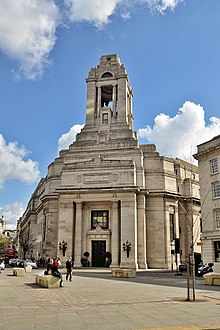Freemasonry (architecture)
Architecture associated with Freemasonry includes thousands of buildings worldwide, but for historical reasons it is mainly concentrated on North America and here especially on the USA , where, especially in the decades between 1870 and 1930, a large number of cathedral-like temples of the Freemasons in classicist or "Moorish." “Style emerged ( orientalizing architecture is mainly shown in the buildings serving the rites of the Shriner , a men's association derived from Freemasonry). In the opinion of some authors, the Monument to the Battle of the Nations in Leipzig is also to be seen as Masonic architecture.
history
While Freemasonry in continental Europe after the French Revolution and especially after the end of Napoleon Bonaparte's hegemony came into serious opposition to the majority of the ruling political and religious groups and was thus prevented from building powerful buildings, the United States became essential after the successful War of Independence shaped by Freemasons like George Washington and Benjamin Franklin (and later Andrew Jackson ) and Freemason-friendly politicians like Thomas Jefferson . The moderate Masonic element (without anti-religious thrust) is part of the central legacy of the American Revolution and was able to develop on a broad basis as a result, regardless of the political and religious reservations of other groups. At the height of the Confederation's proliferation, in 1929, 8.6% of the male population in the United States belonged to Freemasonry, and in 1960, with over 4 million members, the penetration rate was 7.6%. Membership in Masonic organizations as a medium-sized mass phenomenon also corresponded to a self-confident architectural self-representation. Especially in the decades between 1870 and 1930, when the USA rose to become the world's leading industrial power after overcoming its civil war, there was therefore an abundance of large-scale Masonic buildings. In the wake of the global economic crisis , many of these representative large buildings had to be devoted to other purposes, and a comparable trend can also be observed in the last few decades. In 1987 a former Masonic temple became the National Museum of Women in the Arts (Washington) and the Egyptian Scottish Rite Temple in Mobile (Alabama) became a restaurant.
Remarkable Masonic buildings
Germany
- Old town hall in Bielefeld
- Lodge house To the three swords
- Hotel Kaisershof (Hamburg)
- Völkerschlachtdenkmal
Spain
Canada
- Masonic Temple (St. John's, Newfoundland and Labrador).
- Masonic Temple in Toronto.
Liberia
Great Britain
- The Cloisters (Letchworth).
- Freemasons' Hall (London) , home of the United Grand Lodge of England .
- New Welcome Lodge.
- Rosslyn Chapel
United States
- Masonic Temple of Philadelphia , Pennsylvania
- George Washington National Masonic Memorial , Alexandria, Virginia.
- House of the Temple , Washington, DC
- Masonic Temple (Glendale, California).
- Masonic Temple (Detroit) .
- Masonic Temple (Chicago) .
- Salt Lake Masonic Temple, Salt Lake City, Utah.
- New York City Center , New York, New York, built as the Shriners' "mosque".
- The New Masonic Temple (Saint Louis, Missouri) .
- Moolah Theater and Lounge (Saint Louis, Missouri) also a Shriners structure.
- Shrine Auditorium (Los Angeles), California, another construction of the Shriners.
- Masonic Center (San Francisco) , California.
- Temple of the Grand Lodge of Massachusetts , Boston
- Tripoli Shrine Temple (Milwaukee) , Wisconsin , modeled on the Taj Mahal .
International impressions
Masonic Temple in Brisbane .
Masonic Lodge in Yeovil .
Pollkshield's Burgh Hall in Maxwell Park ( Glasgow ).
Former Masonic Temple in Oakland, now a University of Pittsburgh building .
Masonic Temple in Washington, DC, ( USA ).
Masonic temple in Saint Helier (Channel Island Jersey ).
Masonic temple in Shanghai with the Medical Association as a tenant.
Norwegian Masonic Temple in Oslo .
Swedish Masonic Temple in Karlstad .
Lodge house in Winterthur .
Lodge house in Groningen .
Lodge house in Mons .
Masonic temple in Copenhagen .
Children's Hospital of Shriners on the campus of Oregon Health and Science University in Portland (Oregon) .
Lodge house in Viborg .
Masonic temple in Avaré ( Brazil ).
Masonic Temple in Quincy, Massachusetts .
Lodge house in Colmar .
Freemasons Hall in Singapore .
Masonic temple in Arecibo ( Puerto Rico ).
Phytagoras on the three rivers in Hann. Münden : The lower part of the lodge house was a historical bulwark.
"To the truth and friendship" in Fürth
literature
- William D. Moore: Masonic Temples. Freemasonry, Ritual Architecture, and Masculine Archetypes. Knoxville 2006.
Web links
- Saint Louis, Missouri, New Temple from 1926
- George Washington Masonic Memorial
- Masonic Temple Washington DC , an Old Accepted Scottish Rite building , modeled after the Mausoleum at Halicarnassus
- Details of the Scottish Temple in Washington
- Pennsylvania Grand Lodge
- A replica of the Taj Mahal
Individual evidence
- ↑ a b Alexander Suss: Leipzig Freemasons in word and stone. The influence of the lodges on the Völkerschlachtdenkmal and the book city. Salier Verlag, ISBN 978-3939611448 .
- ↑ Figures based on John L. Belton in: Arturo de Hoyos, S. Brent Morris: Freemasonry in Context. Lanham, Maryland 2004, p. 314.
- ↑ The secret of the Leipzig Völkerschlachtdenkmal. MDR television , May 3, 2012, archived from the original on November 17, 2011 ; accessed on September 29, 2016 .





























